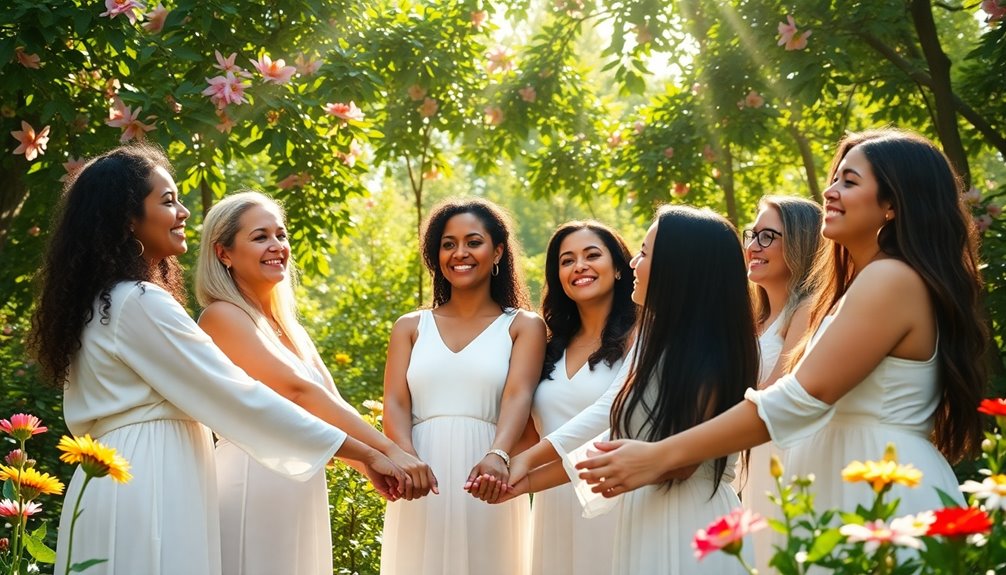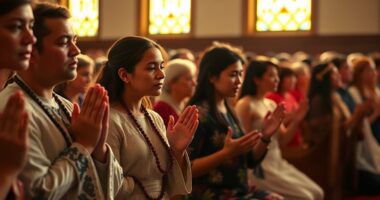The Bride of Christ symbolizes the deep, loving relationship between you and Jesus. It's about commitment and unity as you wait for His return. Scripture like Ephesians 5:25–27 highlights His sacrificial love for the church, showing that this bond reflects the purity and faithfulness of a bride. Just as a bride prepares for her groom, you're called to spiritual readiness in this covenant relationship. This imagery culminates in the joyous union during the rapture. Understanding this concept can enrich your spiritual journey and connection with others, and there's plenty more to explore on this profound topic.
Key Takeaways
- The Bride of Christ symbolizes the collective identity of all believers, reflecting their spiritual union and commitment to Jesus.
- Ephesians 5:25–27 illustrates Jesus' sacrificial love for the church, emphasizing the call for purity and faithfulness among believers.
- Ancient Jewish wedding customs highlight the anticipation of the rapture, where the church awaits its ultimate union with Christ.
- Misinterpretations often view the bride as solely a physical entity, neglecting the spiritual unity of all genders in Christ.
- The marriage of the Lamb in Revelation 19:7–9 signifies the eschatological culmination of the church's relationship with Christ.
Introduction

The concept of the "bride of Christ" invites you to explore the profound relationship between the church and Jesus, emphasizing love, commitment, and faithfulness. As a believer, you're part of this collective bride, eagerly awaiting the promised union with Christ. This anticipation is celebrated during the rapture, illustrated in Revelation 19:7–9, where the bride is joyfully united with her groom.
In Ephesians 5:25–27, the depth of commitment is portrayed, where Jesus loves the church and sacrificed Himself for her, underscoring the call for you to reflect that same devotion.
Scriptural references, like 2 Corinthians 11:2, describe the church as a chaste virgin, highlighting the importance of purity and faithfulness during this betrothal phase.
The imagery of the New Jerusalem in Revelation 21:2 further emphasizes the church adorned as a bride, revealing the glory and holiness expected of Christ's followers.
Bridal theology has shaped many Christian traditions, urging you to cultivate a deep, personal relationship with Jesus, much like the lives of saints such as Catherine of Siena and Teresa of Ávila.
Embrace this beautiful identity and live out your role as part of Christ's beloved bride.
Scriptural Basis for the Bride

The concept of the Bride of Christ is beautifully illustrated in various scriptures that highlight this profound relationship.
In Ephesians 5:25-27, Paul draws a powerful parallel between marriage and Christ's love for the church, while Revelation 19:7-9 celebrates their joyous union.
Primary Bible References
Throughout Scripture, the imagery of the bride of Christ is vividly illustrated, showing the deep and intimate connection between Christ and His church. In Ephesians 5:22–33, Paul compares this relationship to that of a husband and wife, emphasizing love, unity, and mutual respect. This powerful analogy underscores the commitment expected from both Christ and His body of believers.
Revelation 19:7–9 celebrates the marriage of the Lamb, highlighting the righteousness of the saints, adorned in fine linen, as a reflection of their purity and devotion. Meanwhile, 2 Corinthians 11:2 portrays the church as a chaste virgin espoused to Christ, reinforcing the importance of faithfulness in this divine relationship.
Additionally, Revelation 21:2 depicts the New Jerusalem as a bride beautifully adorned for her husband, symbolizing the ultimate fulfillment of the union between Christ and His people.
This imagery is rooted in Old Testament symbolism, such as Isaiah 54:5, which describes God as a husband to His people, illustrating the covenant relationship. Together, these passages form a rich tapestry of the bride of Christ, emphasizing commitment, purity, and the promise of eternal union.
Secondary Bible References
In exploring the concept of the bride of Christ, several secondary Bible references enrich our understanding of this profound relationship. Ephesians 5:22-33 draws a parallel between the bond of a husband and wife and that of Christ and the church, emphasizing the deep love and commitment required.
Revelation 19:7-9 celebrates the marriage of the Lamb, highlighting the church's righteous acts as fine linen, which signifies purity and devotion. Paul, in 2 Corinthians 11:2, expresses his concern for the church as a chaste virgin espoused to Christ, reinforcing the significance of faithfulness in this union.
Moreover, Revelation 21:2 and 9 present the New Jerusalem as a bride beautifully adorned for her husband, symbolizing the eternal union of believers with Christ.
This imagery isn't exclusive to the New Testament; the Old Testament also contains reflections of God's desire for a faithful relationship with His people, notably in the Song of Songs and Hosea.
Together, these secondary references deepen your understanding of the bride's identity and the church's role in this divine relationship, reminding you of the importance of purity, commitment, and the ultimate union with Christ.
Ancient Wedding Customs Influence Symbolism

Ancient wedding customs frequently provide rich symbolism that deepens our understanding of the relationship between Christ and the church. In Jewish wedding customs, the betrothal period represents a formal engagement, mirroring the Church's current waiting for Christ as the Bridegroom. During this time, the bride is adorned with beautiful garments and jewelry, reflecting the imagery of the Church being presented to Christ in splendor, as emphasized in Ephesians 5:27.
As the wedding ceremony unfolds, the groom takes the bride to his home, symbolizing the anticipation of the rapture when believers will be united with Christ. This act highlights the hope and joy of that future moment.
Additionally, the custom of the groom paying a bridal price signifies the sacrificial love of Christ, who gave His life for the Church, demonstrating His profound commitment.
Moreover, the bride's family prepares her for marriage, paralleling the Church's role in spiritual preparation and sanctification in anticipation of the eternal union with Christ.
These ancient customs not only enrich our understanding of biblical themes but also remind us of the deep connections between love, commitment, and divine relationship.
Covenantal Relationship With Christ

The covenantal relationship between Christ and the church stands as a profound illustration of love, commitment, and faithfulness, akin to the bond of marriage. Just as a bride prepares for her groom, you're called to remain faithful and pure as you await Christ's return.
This betrothal period emphasizes your devotion, mirroring the love He's for us. In Ephesians 5:25–27, you see Christ's deep commitment to the church, which He cherishes and nurtures.
Anticipation builds as you look forward to the culmination of this covenant at the rapture, where the official unification of Christ and His bride will be celebrated in a magnificent wedding feast, as described in Revelation 19:7–9.
The New Jerusalem, depicted as a bride adorned for her husband in Revelation 21:2, highlights the beauty and holiness you're meant to embody. This identity as the bride of Christ underscores your collective spiritual intimacy with other believers.
You're all preparing for an eternal union, illustrating the depth of this covenantal relationship, rooted in love and commitment. Embrace this calling and let it shape your faith journey.
Misunderstandings About the Bride Symbolism

When you think about the bride of Christ, it's easy to fall into common misconceptions that limit its true meaning.
Many people interpret the bride symbolism through cultural lenses, confusing it with romantic love or seeing it solely as the church.
Understanding the deeper theological implications can help clarify how this imagery reflects our collective identity and commitment to Christ.
Address Common Misconceptions
Throughout history, many misunderstandings have clouded the true meaning of the bride of Christ symbolism. One common misconception is viewing the bride as a physical entity or solely as the institutional church. In reality, the bride represents the collective identity of all believers spiritually united with Jesus as their Savior. This relationship is deeply personal, reflecting how individual followers, regardless of gender, engage in this spiritual union with Christ.
Another misconception involves interpreting the bride as exclusively female. Both men and women are called to participate in this symbolism, as Galatians 3:28 reminds us that we're all one in Christ.
Additionally, some confuse the imagery of the bride with the New Jerusalem, which, while adorned as a bride, is distinct from the church—the actual bride of Christ.
Finally, these misconceptions can lead to neglecting the importance of holiness and preparation central to the bride's concept. As believers, you're called to live righteously, anticipating Christ's return, as emphasized in Revelation 19:7-8.
Understanding these nuances can deepen your appreciation of the bride of Christ and the relationship you share with Him.
Cultural Interpretations of Bride Symbolism
Cultural interpretations of the bride symbolism often miss the mark, leading to confusion about its true meaning. Many view the bride of Christ as a literal entity rather than understanding it as a symbolic representation of the collective church and its relationship with Christ. This misunderstanding can result in the erroneous belief that only female believers are part of this identity, ignoring that all members of the church, regardless of gender, share in this calling.
Moreover, some interpretations conflate the New Jerusalem—described as a bride in Revelation—with the church itself, failing to recognize the distinct roles each plays in scripture. In certain cultural contexts, the bride symbolism leans towards romantic notions, emphasizing emotional attachments rather than the deep commitment and faithfulness expected in the relationship between Christ and the church.
Additionally, teachings may distort bridal imagery by suggesting the church is merely passive, waiting for Christ. This overlooks the essential active role of the church in preparation and holiness during the betrothal period.
Understanding the bride symbolism accurately can help you appreciate the profound relationship between Christ and the church as the bride.
Spiritual Growth Through Community

When you engage in prayer with fellow believers, you deepen your intimacy with God and each other.
This shared experience fosters unity among the community, creating a supportive environment for spiritual growth.
Together, you can strengthen your faith and prepare for the return of Christ as the bride He desires.
Intimacy in Prayer Life
Intimacy in your prayer life can significantly deepen through community engagement, where believers come together to share experiences and support one another. When you participate in corporate prayer, you not only strengthen your bond with the Lord Jesus but also embrace the collective identity of the church as His bride.
Engaging in prayer for one another cultivates an environment of accountability and encouragement, which is essential for your spiritual growth. As you join in communal prayers and worship, you get to experience the richness of the body of Christ.
This shared experience deepens your understanding of His love and commitment, allowing you to appreciate the diverse ways God works through each member of the community. In these moments, you can feel the anticipation of Christ's return growing within you, reinforcing the hope of eternal union with Him.
Ultimately, prioritizing intimacy in prayer life within your community prepares you for a more profound relationship with the Lord Jesus. By investing in these collective moments, you're not just praying; you're weaving together the fabric of faith that binds you to the body of Christ and enriches your spiritual journey.
Fostering Unity Among Believers
Unity among believers serves as a powerful catalyst for spiritual growth within the church community. As you engage with fellow believers, you foster a bond that strengthens your faith in Jesus. Ephesians 4:3 reminds you to maintain the unity of the Spirit, which is crucial for reflecting Christ's love.
The Church acts as the bride of Christ, collectively responsible for nurturing an environment that promotes holiness and righteousness.
Look back at Acts 2:42–47; the early church exemplified unity through fellowship, teaching, and breaking bread together. These shared experiences not only deepened relationships but also reinforced their commitment to one another.
When you bear each other's burdens, as Galatians 6:2 encourages, you create a culture of mutual encouragement and accountability that propels spiritual growth.
Eschatological Significance of Marriage

Often, the eschatological significance of marriage serves as a profound reminder of the relationship between Christ and the Church. In Revelation 19:7-9, the marriage of the Lamb represents the ultimate union between Christ and His bride, the Church, culminating in a heavenly celebration that you can anticipate.
This betrothal period reflects our current church age, where your faithfulness to Christ prepares you for the rapture and the grand wedding feast.
Ephesians 5:25-27 illustrates the sacrificial love of Christ for His bride, emphasizing how deep commitment and devotion are essential in this eschatological relationship.
As you consider your role within the Church, remember that the New Jerusalem, adorned as a bride in Revelation 21:2, symbolizes the final state of the Church in eternal union with Christ. This imagery underscores the importance of remaining pure and prepared for His return, as highlighted in 2 Corinthians 11:2 and Revelation 22:20.
Ultimately, understanding the eschatological significance of marriage invites you to reflect on your relationship with Christ, inspiring you to remain devoted and ready for His glorious return.
Additional Resources

To further enrich your understanding of the church as the bride of Christ, several valuable resources are available. One highly recommended reading is "The Church in God's Program" by Robert Saucy. This book explores the role and identity of the church as the bride, offering insights that illuminate your studies.
Utilizing Bible study tools like Logos Bible Software can also enhance your grasp of the biblical texts related to this theme. Scriptural passages such as Ephesians 5:22–33 and Revelation 19:7–9 will be presented to deepen your comprehension of the symbolic and theological implications surrounding the church.
Additionally, consider delving into the writings of influential figures in bridal theology, like Catherine of Siena and Teresa of Ávila. Their perspectives on the mystical relationship between believers and Christ provide profound insights.
Exploring the concept of bridal mysticism, particularly from the 13th century, can also enrich your understanding of the spiritual dynamics at play. Engaging with these resources won't only enhance your knowledge but will also deepen your appreciation for the church's role as the bride of Christ within the New Testament framework.
Frequently Asked Questions
Who Is the Bride of Christ According to the Bible?
In the Bible, the term "bride" symbolizes a close, loving relationship. It often represents a community or a group of believers united in faith, reflecting qualities like purity and commitment.
This collective body is called to embody righteousness and holiness, eagerly anticipating a future union. The imagery of a bride emphasizes devotion and fidelity, illustrating how you, as part of this community, are encouraged to live in a way that honors that relationship.
How Do You Become the Bride of Christ?
To become part of something greater, you need to accept Jesus as your Lord and Savior. Acknowledge His love and commit to living a life aligned with His teachings.
Participate in sacraments like baptism to symbolize your entry into the faith. Engage in a personal relationship with Him through prayer and scripture.
Strive for holiness and righteousness, preparing yourself for the ultimate union that awaits you in the future.
Why Are Nuns Called Brides of Christ?
Nuns are called brides of Christ because they dedicate their lives to God through vows of chastity, poverty, and obedience.
This commitment symbolizes a profound spiritual union, reflecting the love and devotion found in marriage. By living a life of service and prayer, nuns embody the sacrificial love that Jesus has for His followers.
Their identity as brides signifies purity and faithfulness, emphasizing their role as devoted members of the church community.
What Is the Bride of Christ Analogy?
The bride analogy highlights a deep, committed relationship, emphasizing love, fidelity, and anticipation.
It symbolizes the bond between two parties, much like a couple preparing for marriage. You see, this analogy illustrates how one should remain devoted and pure while awaiting a significant union.
It encourages you to cultivate faithfulness and holiness, reflecting the commitment expected in such a relationship while preparing for a joyful future together.










